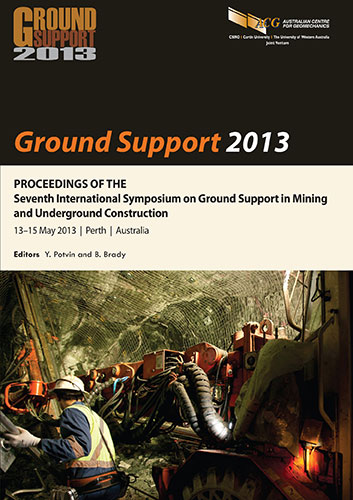Geotechnical analysis and ground support selection for the Ernest Henry crusher chamber

|
Authors: Campbell, AD; Lilley, CR; Waters, S; Jones, PA |
DOI https://doi.org/10.36487/ACG_rep/1304_29_Campbell
Cite As:
Campbell, AD, Lilley, CR, Waters, S & Jones, PA 2013, 'Geotechnical analysis and ground support selection for the Ernest Henry crusher chamber', in Y Potvin & B Brady (eds), Ground Support 2013: Proceedings of the Seventh International Symposium on Ground Support in Mining and Underground Construction, Australian Centre for Geomechanics, Perth, pp. 437-450, https://doi.org/10.36487/ACG_rep/1304_29_Campbell
Abstract:
The Ernest Henry crusher chamber is a large excavation located at a depth of approximately 1 km. During the pre-feasibility study, a single exploration drill hole was extended below the orebody which identified no adverse ground conditions and the crusher location was set. Additional diamond drilling into the planned crusher chamber location was conducted in 2010 and followed by a geotechnical assessment of the life of mine chamber stability. This analysis found that the planned chamber was located almost entirely within a large fault zone, and that the chamber was likely to be unstable. The chamber was relocated as far as the constraints allowed, which ensured that there was no known fault exposure in the chamber backs although the fault zone was still exposed in the walls. The alternate chamber location was found to be more stable, but it was understood that the poor ground conditions would require heavy ground support to ensure life of mine stability. A detailed geotechnical assessment of the revised chamber location was undertaken to assess stability and support requirements, comprising of core logging, structural mapping, rock mass characterisation, empirical and kinematic stability assessments, simple numerical models and benchmarking against crusher chambers at other mines. The excavation sequence was set to minimise damage from over-mining, promote stability via the ground support installation sequence and minimise impacts on the mining schedule. Three-dimensional discontinuum non-linear numerical modelling was used to confirm the sufficiency of the proposed excavation design, sequence and ground support system over the entire life of the mine to identify potential problems and additional support requirements before the chamber was mined. Chamber construction was managed like a civil engineering project with a stringent quality control programme for both mining and ground support. An instrumentation system and on-going monitoring programme were designed to monitor rock mass behaviour and ground support response and compare actual behaviour to the model forecasts.
References:
Barton, N., Lieu, R. and Lunde, J. (1974) Engineering Classification of Rockmasses for the Design of Tunnel Support, Rock Mechanics, Vol. 6, pp. 189–236.
Callahan, M.F., Keskimaki, K.W. and Rech, W.D. (2000) A Case History of the Crusher Level Development at Henderson, in Proceedings MassMin 2000, G. Chitombo (ed), 29 October to 2 November 2000, Brisbane, Australia, Australasian Institute of Mining and Metallurgy, Melbourne, pp. 307–316.
Campbell, A.D. (2011) Geotechnical Assessment of the Crusher Chamber, Xstrata Copper, Ernest Henry Mine, Internal document.
Casten, T., Golden, R., Mulyadi, A. and Barber, J. (2000) Excavation Design and Ground Support of the Gyratory Crusher Installation at the DOZ Mine, PT Freeport Indonesia, in Proceedings MassMin 2000, G. Chitombo (ed), 29 October to 2 November 2000, Brisbane, Australia, Australasian Institute of Mining and Metallurgy, Melbourne, pp. 295–299.
Dight, P. (2011) In-situ Stress Measurement Report Hole EH753, The University of Western Australia, Xstrata Copper, Ernest Henry Mine, Internal Report.
Grimstad, E. and Barton, N. (1993) Updating the Q-System for NMT, in Proceedings On sprayed concrete - modern use of wet mix sprayed concrete for underground support, 18–21 October 1993, Fagernes, Norway, Norwegian Concrete Association, Oslo, pp. 46–66.
Hoek, E., Kaiser, P.K., and Bawden, W.F. (1995) Support of underground excavations in hard rock, Balkema, Rotterdam.
Kaiser, P.K., McCreath, D.R. and Tannant, D.D. (1998) Rockburst support chapter, Rockburst Research Handbook, Canadian Rockburst Research Program 1990–1995, Vol. 1.
Lee, M., Mollison, L., Campbell, A. and Litterbach, N. (2010) Rock Stresses in the Australian Continental Tectonic Plate - Variability and Controls, in Proceedings 11th IAEG Congress – Geologically Active New Zealand, C.Y. Chin, C.I. Massey, T.J. McMorran, G.M. Pinches, A.L. Williams (eds), 5–10 September 2010, Auckland, New Zealand, CRC Press, Boca Raton.
Lilley, C.R. and Beck, D.A. (2012) Modelling of the Ernest Henry Mine Crusher Chamber, Xstrata Copper, Ernest Henry Mine, Internal Report.
Litterbach, N. (2010) Ernest Henry Rock Stress Measurement, Mining Measurement Services Pty Ltd, Xstrata Copper, Ernest Henry Mine, Internal Report.
Mills, K. (2009) In-situ stress measurements at stockpile 3 in main decline at Ernest Henry underground Mine, Xstrata Copper, Ernest Henry Mine, Internal Report.
Villaescusa, E. and Machuca, L. (2011) Stress measurements from oriented core using the WASM AE Acoustic Emission method, Xstrata Copper, Ernest Henry Mine, Internal Report.
Villaescusa, E. and Li, J. (2004) Stress measurements from oriented core using the WASM AE Acoustic Emission method, Xstrata Copper, Ernest Henry Mine, Internal Report.
© Copyright 2024, Australian Centre for Geomechanics (ACG), The University of Western Australia. All rights reserved.
View copyright/legal information
Please direct any queries or error reports to repository-acg@uwa.edu.au
View copyright/legal information
Please direct any queries or error reports to repository-acg@uwa.edu.au